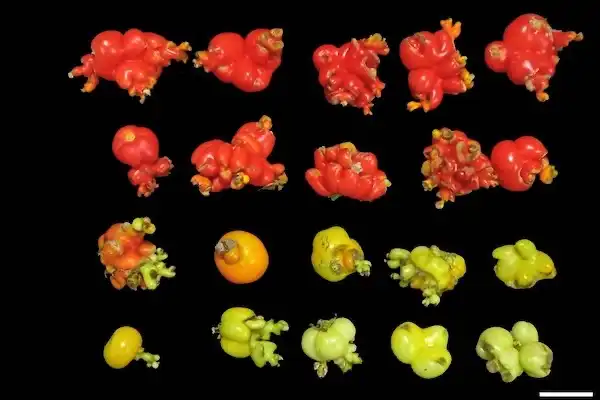In an article published in the journal Development, researchers at the University of São Paulo’s Luiz de Queiroz College of Agriculture (ESALQ-USP) in Brazil describe mechanisms relating to the development of the tomato plant (Solanum lycopersicum) and point to ways of creating novel technologies for tomato yield improvement.
Many processes in plants associated with fruit development occur at the floral meristem, a region rich in stem cells. The tomato plant’s flowers have both a male organ called the androecium, consisting mainly of the anther and pollen, and a female organ, or gynoecium, with ovaries containing ovules (egg cells) for seed and fruit production. Fertilized ovules ripen into seeds, which are covered by fruits. A fruit is technically a ripened ovary.
According to the researchers, even under ideal conditions of pollination and fertilization, the tomato plant can develop only if pathways mediated by microRNAs (small RNA molecules that regulate gene expression) and a hormone called gibberellin interact correctly to trigger initial ovary development.
Almost a decade ago, previous research by the same group demonstrated the effects of a microRNA called miR156 in regulating tomato floral meristem size and shape. Two genetic pathways were described, one involved in the initial establishment of the ovary as fruit and the other in forming seeds inside the fruit.
“Along the way, we realized that these small RNAs could interact with certain plant hormones, which are also important to forming and establishing the ovary and its later development into fruit. One of these phytohormones is gibberellin, which promotes tomato flowering in association with the microRNAs,” said Fábio Tebaldi Silveira Nogueira, the last author of the article. Nogueira is a researcher at the Plant Development Molecular Genetics Laboratory in ESALQ-USP‘s Department of Biological Sciences.
In their latest study, the researchers connected the two sets of findings to show for the first time in the literature that the genetic pathways regulated by miR156 strongly interact with gibberellin when the ovary is formed in the floral meristem.
To understand the process in detail, they analyzed the tomato’s transcriptome (all RNAs expressed by the plant’s genes) and modified it to produce large and small amounts of the phytohormone and microRNA. Initially, this created transgenic plants with more miR156 activity. These were then combined with mutant plants that responded strongly to gibberellin. When they combined these alterations in the same plant, the researchers found that the ovary could not form fruit.
“We observed that when these two pathways are altered and can’t talk to each other—interact defectively or not at all—the floral meristem, which should give rise to the ovary and fruit, develops amorphous structures that don’t form the locular cavities in which seeds should develop. In this manner, we described the initial control of establishing ovary formation in tomato floral meristems, a key stage for the plant to produce fruit later on,” Nogueira said.
He added that even when pollination and fertilization conditions are ideal, the fruit will not be formed unless initial ovary development occurs correctly, with appropriate interaction between the gibberellin and microRNA pathways.
Economic importance
Although there is already plenty of robust information in the scientific literature about the genetics and physiology of plant ovaries, this is the first description of the interaction between microRNAs and gibberellin, especially in as economically important a plant as the tomato.
“This knowledge provides the genetic and physiological basis for manipulating and increasing the number of seeds in a fruit to raise crop yield and even modulate fruit size,” Nogueira said. “It’s worth recalling that seeds are among the most valuable items in both table and industrial tomatoes.”
The researchers now want to find out whether the other pathways for microRNAs and hormones also interact and influence plant development in any way, such as by increasing fruit numbers and sizes, for example.
Read the paper: Development
Article source: FAPESP
Image: A simultaneous rise in the activity of miR156 and gibberellin in the tomato’s floral meristem results in malformed ovaries and misshapen seedless fruit. Credit: ESALQ-USP






